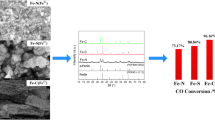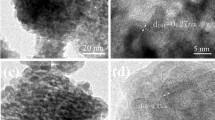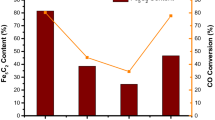Abstract
In this paper, a precipitated iron Fischer–Tropsch catalyst was prepared, which is similar to commercial CNFT-1 catalyst. The performance of as-prepared catalyst was tested for long time reaction of more than 1500 h. The results showed that gradual deactivation of catalyst was observed during the whole reaction period but with different deactivation rates. The activity of the catalyst decreased quickly during the first 500 h and was relatively stable after long time reaction. Catalysts sampled after reduction and different reaction times of 500, 1000 and 1500 h were characterized. As the catalyst was deactivated, α-Fe disappeared but resulted in increasing content of active Fe3C and Fe5C2 species and decreasing content of Fe3O4 for CO2 formation, which indicated the loss of active phase may not be the main influencing factor for the deactivation of precipitated iron catalyst. Sintering of crystallites and graphitic carbon deposition were observed on the samples after long time reaction, which might be responsible for the deactivation of precipitated iron catalyst during long-time reaction.









Similar content being viewed by others
Data availability
All data generated or analyzed during this study are included in this published article.
References
Z. Xu, Review, rethink and prospect of China’s modern coal chemical industry development in recent 25 years. Coal Sci. Technol. 48(8), 1–25 (2020)
F. Dan, H. Liming, D. Shibao, F-T Synthesis of clean fuel and petroleum-based Clean Fuels G-performance comparison. Chem. Industry Times. 33(4), 34–36 (2019)
Z. Yalin, Z. Zhanquan, W. Yan, Z. Zhihua, Comparative analysis of products from Fischer-Tropsch oil and petroleum based oil. Chem. Indus. Engin. Prog. 37(10), 3781–3787 (2018)
E.D. Smit, B.M. Weckhuysen, The renaissance of iron-based Fischer-Tropsch synthesis: on the multifaceted catalyst deactivation behaviour. Chem. Soc. Rev. 37, 2758–2781 (2008)
C. Wendi, L. Deyi, G. Zhongshan, W. Feng, Y. Jinglin, Y. Nan, Developments on deactivation of Fe-based Fischer-Tropsch synthesis catalysts. Industrial Catalysis. 27(6), 9–15 (2019)
Z. Guo, H. Li, Z. Yang (2020) A question and answer on Fischer synthesis device technology, 1st edn. (China Petrochemical Press), 29–30
C. Yang, H. Zhao, Y. Hou, D. Ma, Fe5C2 nanoparticles: a facile bromide-induced synthesis and as an active phase for Fischer−Tropsch synthesis. J. Am. Chem. Soc. 134(38), 15814–15821 (2012)
P. Wang, W. Chen, F.K. Chiang et al., Synthesis of stable and low-CO2 selective ε-iron carbide Fischer-Tropsch catalysts. Sci. Adv. 4(10), 2947 (2018)
H. Zhao, J.X. Liu, C. Yang et al., Synthesis of iron-carbide nanoparticles: identification of the active phase and mechanism of Fe-Based Fischer-Tropsch synthesis. CCS Chem. 2, 2712–2724 (2020)
J.W. Nlemantsverdrlet, A.M. van der Kraan, Behavior of metallic iron catalysts during Fischer-Tropsch synthesis studied with mossbauer spectroscopy, X-ray diffraction, carbon content determination, and reaction kinetic measurements. J. Phys. Chem. 84, 3363–3370 (1980)
D.J. Duvenhage, N.J. Coville, Deactivation of a precipitated iron Fischer-Tropsch catalyst—A pilot plant study. Appl. Catal. A 298, 211–216 (2006)
Q. Chang, C. Zhang, C. Liu et al., Relationship between Iron Carbide Phases (ε-Fe2C, Fe7C3, and χ-Fe5C2) and catalytic performances of Fe/SiO2 Fischer-Tropsch Catalysts. ACS Catal. 8, 3304–3316 (2018)
F. Jiang, B. Liu, W. Li, M. Zhang, Z. Li, X. Liu, Two-dimensional graphene-directed formation of cylindrical iron carbide nanocapsules for Fischer-Tropsch synthesis. Catal. Sci. & Technol. 7, 4609–4621 (2017)
L.D. Mansker, Y. Jin, D.B. Bukur, A.K. Datye, Characterization of slurry phase iron catalysts for Fischer-Tropsch synthesis. Appl. Catal. A. 186, 277–296 (1999)
A.L. Chaffee, I. Campbell, N. Valentine, Sulfur poisoning of fischer-tropsch catalysts in a fixed-bed reactor. Appl. Catal. 47, 253–276 (1989)
Z.T. Liu, Y.W. Li, J.L. Zhou et al., Deactivation model of Fischer-Tropsch synthesis over an Fe-Cu-K commercial catalyst. Appl. Catal. A. 161, 137–151 (1997)
W. Ma, G. Jacobs, D.E. Sparks et al., Effect of H2S in syngas on the Fischer-Tropsch synthesis performance of a precipitated iron catalyst. Appl. Catal. A 513, 127–137 (2016)
L. Weizhen, Progress on the catalyst deactivation model for Fischer-Tropsch synthesis. Chem. Indus. Engin. Prog. 38(5), 2347–2352 (2019)
F. Haghseresht, G.Q. Lu, A.K. Whittaker, Carbon structure and porosity of carbonaceous adsorbents in relation to their adsorption properties. Carbon 37, 1491–1497 (1999)
P. Ayala, M.E.H.M.D. Costa, R. Prioli, Nano- and micro-scale wear of fluorinated carbon films. Surf. Coatings Technol. 182, 335–341 (2004)
Acknowledgements
This work was supported by the National Key Research Programs (2017YFB0602500 and 2018YFE0118200) and Key Research and Development Plan of Shandong Province (2019GSF109109).
Author information
Authors and Affiliations
Contributions
ZL, YL and ZY contributed to the study conception and design. Material preparation, data collection and analysis were performed by HL, WL and ZM. The first draft of the manuscript was written by WL and ZL and all authors commented on previous versions of the manuscript. All authors read and approved the final manuscript. The work was supervised by ZM and ZY.
Corresponding authors
Ethics declarations
Conflict of interests
All authors declare no conflict of interests.
Additional information
Publisher's Note
Springer Nature remains neutral with regard to jurisdictional claims in published maps and institutional affiliations.
Rights and permissions
About this article
Cite this article
Li, H., Liu, Z., Li, W. et al. Deactivation behavior investigation on commercial precipitated iron Fischer–Tropsch catalyst for long time reaction. J Porous Mater 29, 307–315 (2022). https://doi.org/10.1007/s10934-021-01174-1
Accepted:
Published:
Issue Date:
DOI: https://doi.org/10.1007/s10934-021-01174-1




